 Petzlover
Petzlover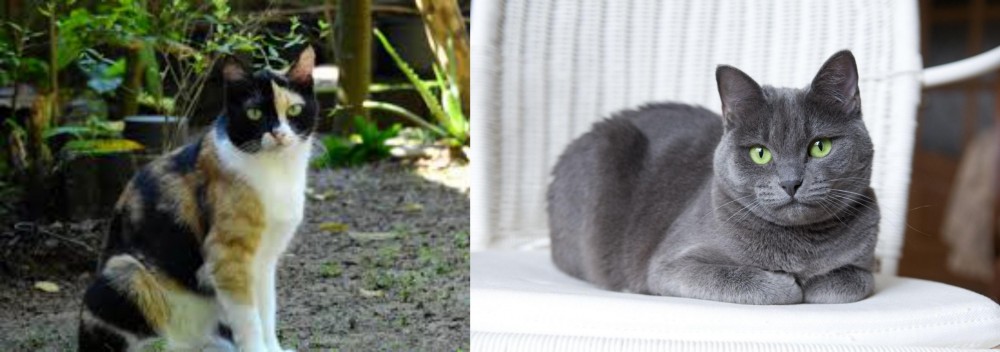 Calico is originated from Egypt but Russian Blue is originated from Russia. Both Calico and Russian Blue are having almost same weight. Calico may live 4 years less than Russian Blue. Both Calico and Russian Blue has same litter size. Both Calico and Russian Blue requires Low Maintenance.
Calico is originated from Egypt but Russian Blue is originated from Russia. Both Calico and Russian Blue are having almost same weight. Calico may live 4 years less than Russian Blue. Both Calico and Russian Blue has same litter size. Both Calico and Russian Blue requires Low Maintenance.
 Nobody can say with certainty where Calico cats originate from, but it is thought they they hail from Egypt, and that they later came to port cities in Spain, Italy and France.
Nobody can say with certainty where Calico cats originate from, but it is thought they they hail from Egypt, and that they later came to port cities in Spain, Italy and France.
Today these cats are found all over the world. Wherever these cats come from, they are 99.9% female and this is because of the cat’s unique chromosomal makeup. Most of the calico or tortoiseshell male cats are because of the chromosome abnormality.
The weird aspect with these amazing cats is because of their unique genetic makeup, and also because of the fact that the males are born sterile, these cats can’t be bred and they can emerge in different litters.
Since 2001 this cat has been Maryland's state cat. An interesting fact is that the Calico became the official cat of the state of Maryland because of its amazing colors of its fur which happen to be fairly similar to that of the Baltimore Oriole, the state bird.
 It is believed that this beautiful cat originates from Russia, and more specifically the Archangel Isles.
It is believed that this beautiful cat originates from Russia, and more specifically the Archangel Isles.
It is also thought that these cats descended from cats that were kept by the Russian Czars and that they arrived in England and Northern Europe during the 1860s. It appeared in cat shows and by 1912 it was given its own classification.
The cat was also introduced to the United States in the early 1900s and today it is a popular domesticated pet.
 Calico cats are known for their jaunty tri-colored coats with color such as white, black and orange. In fact, to be known as a Calico cat, these 3 colors need to be present, Calico isn’t a breed of cat as such, but is actually referring to the cat’s color variations.
Calico cats are known for their jaunty tri-colored coats with color such as white, black and orange. In fact, to be known as a Calico cat, these 3 colors need to be present, Calico isn’t a breed of cat as such, but is actually referring to the cat’s color variations.
Some of the most distinctive breeds of cars such a the Cornish Rex and Persians have these calico coats. One odd spec with these cats is that nearly all calico cats are female and this is because of the chromosomal makeup.
Size, coat texture, shade of coat, coat length and ear shapes can all vary with the type of calico cats you get so their weight can be anything from 3 to 7kg.
As mentioned, Calico cats aren’t a specific breed, and that is why it is actually difficult to describe the personality of a calico cat.
You’ll find certain calico cat owners describing their cat’s behavior but you won’t find any particular scientific studies of the cat’s personality. You could have a calm cat, one that is laid-back, a very vocal cat or a very active cat. In other words, these cats can be quiet, calm, excitable, friendly, shy, or mellow – their personality is formed from the way they are brought up and socialized.
 The medium-sized Russian blue cat is slender, strong, and muscular with long legs. He can weigh between 3 and 6kg.
The medium-sized Russian blue cat is slender, strong, and muscular with long legs. He can weigh between 3 and 6kg.
He has a beautiful blue, soft double coat that is short and thick. The coat is an even color with silver tips. What is an attractive feature of this cat too is that his double coat doesn’t shed much. The cat has a triangular-shaped head with yellow to green eyes.
The Russian Blue is such an amicable, sweet-tempered cat that likes nothing more than to be in the company of his human owners, He is calm and independent. They do well living with their human families but they do tend to form a deep bond with that one special person.
He will even follow his owner everywhere and is a loving, loyal companion. The Russian Blue is a social cat but also enjoys some quiet time out just to chill. He also isn’t too fond of visitors and may run away and hide if the occasion becomes too large and noisy.
This is a cat that will miss you when you’re at work all day but he is able to quietly wait for your arrival back home. Then he will appreciate some playtime.
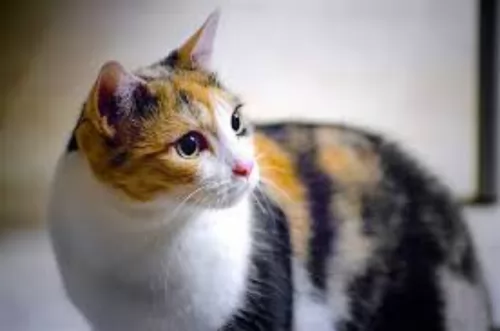 The Calico is such an amazing type of cat and because it comes from so many cat breeds, the personality will vary, although having said that, there are a few characteristics that seem to be specifically attributed to the Calico cat.
The Calico is such an amazing type of cat and because it comes from so many cat breeds, the personality will vary, although having said that, there are a few characteristics that seem to be specifically attributed to the Calico cat.
One thing is for sure, these are intelligent, sweet, appealing, warm-hearted, loving cats that are good with children too. Perhaps in keeping with the quirky, jaunty coat, there is some quirkiness in the personality too, but that is precisely what makes these amazing cats the interesting characters they are.
To add to that, when you do research, you find that some have acted in bravey and saved their humans from harm in one way or the other.
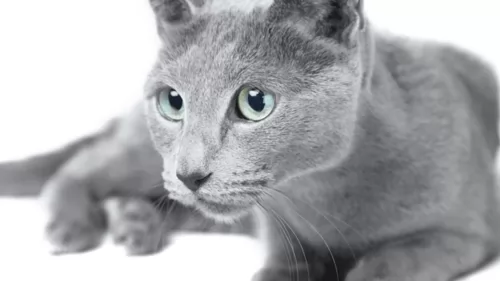 Your Russian Blue is such an intelligent cat and for this reason, when you bring one into your home, you’ll need to provide him with lots of stimulating toys and fun play times.
Your Russian Blue is such an intelligent cat and for this reason, when you bring one into your home, you’ll need to provide him with lots of stimulating toys and fun play times.
This is also a low maintenance cat and a brush once a week will be all that is required.
These are cats that love their mealtimes and you’ll want to work out a special eating program to ensure he gets all the nutrition he needs without over-eating.
Respond with lots of love and attention to your vocal Russian Blue, and you’ll soon see what a precious jewel this cat is as a companion and friend.
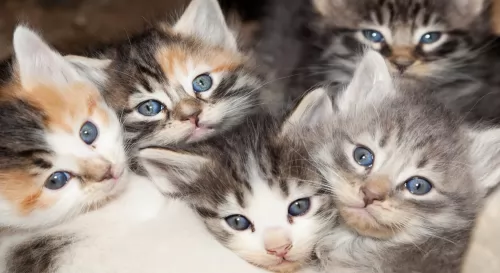 The lifespan of the Calico cat be anything really and if you provide your calico with a wonderful home it will be able to reach 15 years of age.
The lifespan of the Calico cat be anything really and if you provide your calico with a wonderful home it will be able to reach 15 years of age.
Sometimes Klinefelteris Syndrome is a threat with this cat as a result of the XXY chromosomes. Their health is impacted because the disease can cause problems such as increased body fat and reduced bone mineral content.
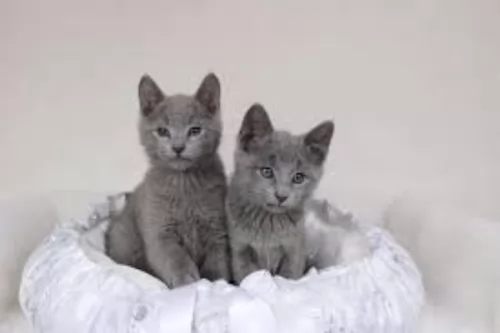 Because the Russian Blue is a naturally occurring breed, they are fairly healthy cats. Watch out for obesity and urinary tract infections with your cat.
Because the Russian Blue is a naturally occurring breed, they are fairly healthy cats. Watch out for obesity and urinary tract infections with your cat.
Obesity shortens a cat’s life. It puts extra pressure on the cat’s joints and it makes them more likely to develop disease. Then again, it is dangerous to suddenly put your obese cat on a strict diet so that he loses weight too quickly.
Your cat requires a gradual decrease in body weight. If you’re worried about your cat’s weight, rather speak to a veterinary surgeon who can explain to you and also draw up a weight loss program for your cat.
Remember too, that cats are carnivores and they simply have to have meat in their diet. Commercially manufactured cat foods of the highest quality are high in protein and low in carbohydrates.
Feline lower urinary tract disease is no joke for a cat. This disease affects your pet’s lower urinary tract – the bladder. Causes include bladder stones or bladder infections and inflammation in the urinary bladder.
You may notice your cat battling to urinate. Your cat will also no doubt cry out while trying to urinate and this is because the process is so painful. There may also be blood in the urine.
You may notice that your cat isn’t using his litter box but urinating elsewhere. Your cat will need to get to the vet as soon as possible. It may not be a life-threatening disease but it can be highly uncomfortable for your cat.
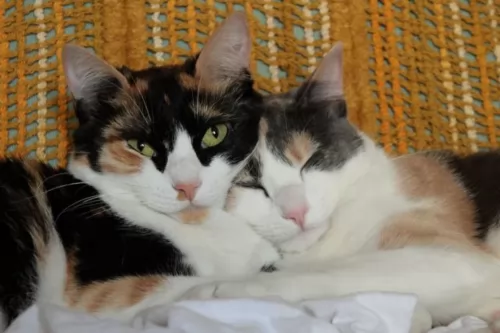 Gently brush the Calico’s fur from time to time to ensure the jaunty colored coat is always shiny and healthy. It helps with the removal of dead hair as well and the cat enjoys the attention.
Gently brush the Calico’s fur from time to time to ensure the jaunty colored coat is always shiny and healthy. It helps with the removal of dead hair as well and the cat enjoys the attention.
Every cat requires vaccines to prevent him from getting the deadly cat viruses there are, and to keep the cat free from parasites.
If there are any warning signs that there’s something wrong with your Calico, get him to the vet immediately.
Your Calico kitten will need to receive 3 meals a day. As your cat matures, two smaller meals a day will be good for your cat. You’ll find both canned- and dry packaged foods and your cat will let you know which one he prefers.
Your adorable Calico may beg for treats in between but as a responsible pet owner, make sure you don’t allow your Calico to overeat as obesity brings its own set of health issues.
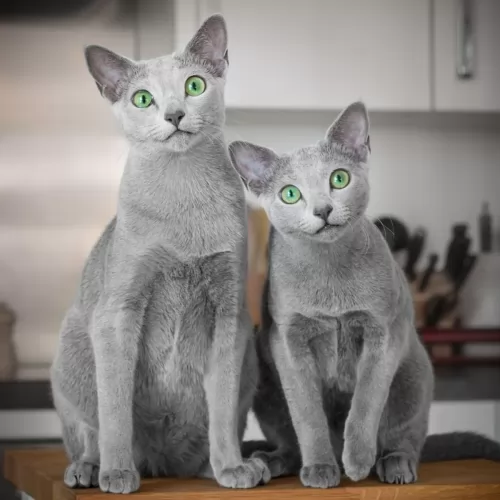 The Russian Blue’s beautiful blue coat is short and thick and will do well with a brush once a week. The cat just thrives on the attention during brush time too.
The Russian Blue’s beautiful blue coat is short and thick and will do well with a brush once a week. The cat just thrives on the attention during brush time too.
Trim your Russian blue’s nails regularly.
Provide your cat with everything he needs to make his life pleasant. Food and water bowls, a litter box, a collar and tag, a nice soft bed, grooming accessories, climbing tree, and a scratching post.
Make sure he has his cat vaccines and is treated for parasites.